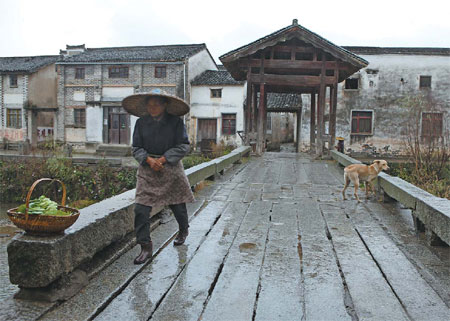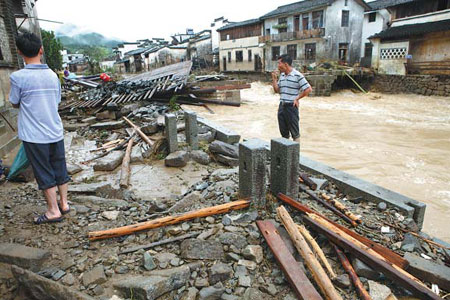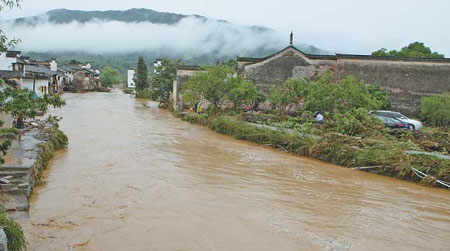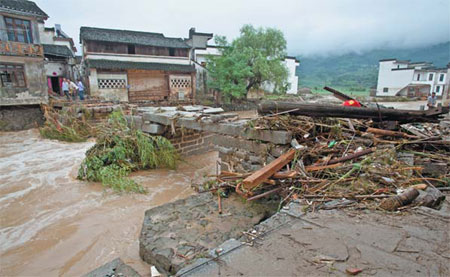Bridging hope and history
Updated: 2013-08-04 08:08
By Sun Yuanqing and Ji Beibei(China Daily)
|
|||||||||
|
Built in the Yuan Dynasty, Huanxiu Bridge is the oldest of its kind in Huizhou, Anhui province. This photo was taken in 2010 before it was destroyed.Photos by Zhang Jianping / for China Daily |
|
Huanxiu Bridge collapsed during a flash flood in June and most of it was swept away, leaving only parts of two piers. When the flood receded, villagers trekked miles along the river to salvage any parts they could find. |
|
The Zhongchuan River narrows at the point where Huanxiu Bridge stands. |
|
The torrents destroyed the wooden pavilion on top of Huanxiu Bridge, and the stones that bolstered the central arches. Zhang Jianping / for China Daily |
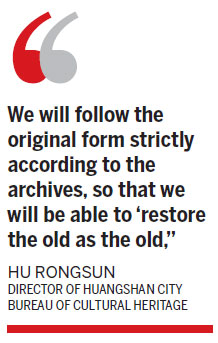
An unexpected disaster has become a rallying call to preserve heirloom and heritage, galvanizing a whole community into realizing how fragile some traditions can become. Sun Yuanqing and Ji Beibei report from Beijing and Chengkan in Anhui province.
For more than seven centuries the bridge had been where village elders gather to gossip and lovers meet to whisper sweet nothings. It is also where the young and adventurous set off to make their fortunes and families part and unite. Huanxiu Bridge was very much part of the scenery in Chengkan, Anhui province and had guarded the village so long that no one really noticed it anymore. That is, until it collapsed during a flash flood in June this year and was swept away. The torrents destroyed not just the wooden pavilion on top of the bridge, but also the stones that bolstered the central arches, leaving only parts of two piers.
"It happened within a second," says Zhen Xinxue, an 82-year-old villager, as she gazed at the remains of the bridge. "Boom! It was over. I was so scared. That was the largest flood I had ever seen."
Zhen is not the only one who found it hard to accept the destruction of the bridge. As soon as the flood receded, villagers went downstream to search for the remnants of the bridge.
While the stone foundations were still lying in the river, the wooden parts had all been washed away. The villagers trekked miles along the river to salvage anything they could find, and identified the wooden components by the particular tenons and joints, and inscriptions.
Neighboring villages joined in the effort. Fang Shunlai, manager of the Chengkan Tourism Company, stopped the regular clearing of debris in the waterway as soon as he heard about the incident and rallied his own teams to join the recovery.
One month later, as much as 75 percent of the broken wooden parts of the bridge has been collected, and the bridge is now looking forward to a resurrection and a new connection to its storied past.
Built in the Yuan Dynasty (1271-1368), Huanxiu Bridge is the oldest of its kind in Huizhou, a historical region in Anhui province, famous for its architectural heritage.
Hui-style architecture, one of the major genres in ancient Chinese structures, is known for its signature combination of gray tiles and white walls. The area is still full of clusters of exquisite homes, ancestral halls and memorial archways.
"Huanxiu Bridge is like the soul of this area," says Zhang Jianping, a photographer who has been taking pictures of Hui-style architecture for more than two decades.
"It might look primitively simple, but its granite deck, wooden pavilion and gray tiles all represent the essence of different times," Zhang says.
Huanxiu Bridge, along with 48 other structures in the village, was listed as a major historical and cultural site protected at the national level by the State Administration of Cultural Heritage, making Chengkan the only village in China with so many national treasures.
Legend has it that the bridge was built by a local woman whose husband died when doing business far from home. She made up her mind to save every penny to build a bridge so that it would be easier for local residents to connect to the outside world.
The bridge was a vital thoroughfare for Hui businessmen, who were the major drivers of Chinese commerce in ancient times. Today, it is still an important passageway for villagers.
"Without the bridge, they would have to detour by a far away road in the mountains," says local resident Wang Chunxia.
More than that, the bridge is a gathering place for the local community.
"We have grown attached to it," Wang says. "Since I was a child, it has been a place where we hang out and chat. For the young ones, this is the place to meet and fall in love."
Hopefully, the bridge will be all these and more again, when it is restored by the end of November, says Hu Rongsun, director of Huangshan city bureau of cultural heritage. The rest of the bridge that could not be recovered will have to be replaced, he says.
"We are not in a hurry to get the stone components back from the water. Moving them now may cause possible damage. It would be better to start evacuating only when the whole restoration plan is ready," Hu says.
The restoration will follow the blueprint of the 100-year-old Wind Rain Bridge in Guizhou province, successfully restored in 2006 after local villagers salvaged parts after a destructive flood. "We will follow the original form strictly according to the archives, so that we will be able to 'restore the old as the old'," says Hu.
Experts from the Chinese Academy of Cultural Heritage have worked out a restoration plan, which will have to be authorized by the State Administration of Cultural Heritage before it is implemented in early October. The restoration is expected to take two months.
But, activists following the progress of the restoration are concerned. "My major concern is if all the original materials will be saved in the restoration process," says Zhang, the photographer. He says one of the major problems in architecture restorations in the Huizhou area is the casual replacement of the old by the new.
Huanxiu Bridge is built from a particular kind of granite that comes from the Huizhou area. The wooden benches have been polished smooth after having served for hundreds of years. The inscription that hung over the roof of the pavilion has recorded the three names the bridge used in times of Yuan Dynasty, Qing Dynasty (1644-1911) and the period during the "cultural revolution" (1966-76).
"All these are traces of time," Zhang says. "Some of them may have been broken or partially damaged, but they should still be repaired rather than be replaced. If new materials are used, then they must be of the same quality and from the same source."
Contact the writers at sun-yuanqing@chinadaily.com.cn and jibeibei@chinadaily.com.cn.
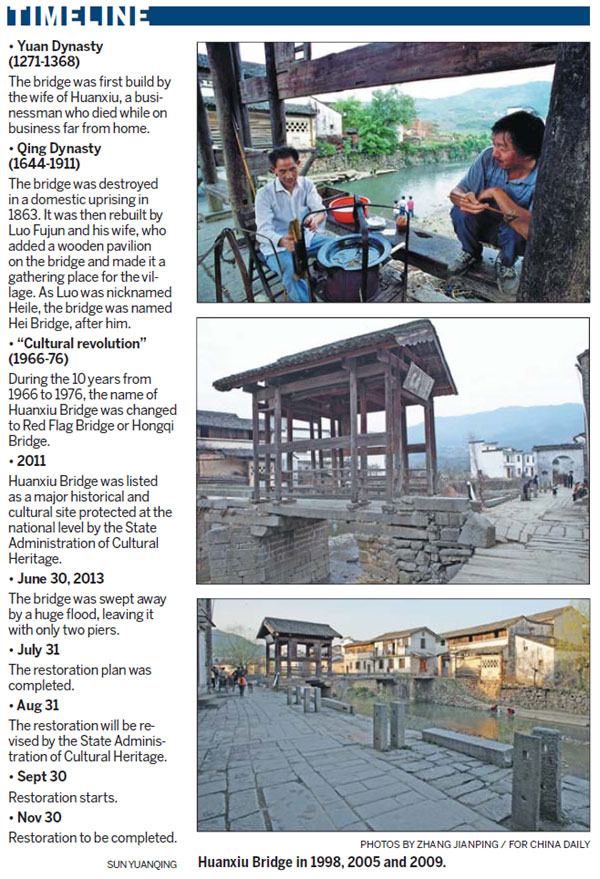
(China Daily 08/04/2013 page1)
